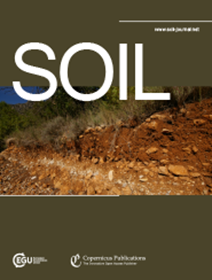Interplay of coprecipitation and adsorption processes: deciphering amorphous mineral–organic associations under both forest and cropland conditions
IF 4.3
2区 农林科学
Q1 SOIL SCIENCE
引用次数: 0
Abstract
Abstract. Mineral–organic associations are crucial carbon and nutrient reservoirs in soils. However, conversion from forest to agricultural systems disrupts these associations, leading to carbon loss and reduced soil fertility in croplands. Identifying the types of mineral–organic associations within a single soil is already challenging, and detecting those susceptible to disruption during forest-to-crop conversion is even more complex. Yet, addressing this identification challenge is essential for devising strategies to preserve organic matter in croplands. Here, we aimed to identify the predominant mineral–organic associations within an Andosol (developed on Fe-poor parent material) under both forest and cropland conditions. To achieve this, we collected Andosol samples from both a forested and a cultivated area, located 300 m apart. We then analyzed differences between the two soil profiles in soil physicochemical parameters and characterized mineral–organic associations using an array of spectro-microscopic techniques for comprehensive structural and compositional analysis. At microscale and nanoscale spatial resolution, we observed mineral–organic associations in the form of amorphous coprecipitates, composed of a mix of C+Al+Si and C+Al+Fe+Si nanoCLICs (inorganic oligomers with organics), proto-imogolites and organic matter, some Fe nanophases associated with organic matter, and some metal–organic complexes. This challenges prior conceptions of mineral–organic associations in Andosols by demonstrating the presence of amorphous coprecipitates rather than solely organic matter associated with short-range-order minerals (i.e., imogolite and allophanes). Moreover, chemical mappings suggested that these amorphous coprecipitates may adhere to mineral surfaces (i.e., phyllosilicates and imogolites), revealing secondary interactions of mineral–organic associations in soils. While the presence of similar amorphous coprecipitates in both the forest and crop Andosols was confirmed, the crop soil had 75 % less C in mineral–organic associations (in the 0–30 cm depth). Although the sample size for comparing land use types is limited, these results suggest that the nature of mineral–organic associations remains identical despite quantitative differences. This study highlights the crucial role of amorphous coprecipitates in C stabilization in Andosols and also suggests their vulnerability to disruption after 30 years of a forest-to-crop conversion, thereby challenging our understanding of the persistence of mineral–organic associations in Andosols.共沉淀和吸附过程的相互作用:在森林和农田条件下解读无定形矿物-有机结合
摘要。矿物-有机组合是土壤中重要的碳和养分储存库。然而,从森林向农业系统的转变破坏了这些联系,导致碳损失和农田土壤肥力下降。在单一土壤中识别矿物-有机联系的类型已经具有挑战性,而在森林向作物转化过程中检测易受破坏的类型则更加复杂。然而,解决这一识别挑战对于制定保护农田有机质的策略至关重要。在这里,我们旨在确定在森林和农田条件下Andosol(在贫铁母质上发育)中主要的矿物-有机组合。为了实现这一目标,我们从相隔300米的森林和耕地地区收集了安多酚样本。然后,我们分析了两种土壤剖面在土壤物理化学参数上的差异,并利用一系列光谱显微镜技术进行了全面的结构和成分分析,表征了矿物-有机组合。在微尺度和纳米尺度的空间分辨率下,我们观察到矿物-有机结合以无定形共沉淀的形式存在,由C+Al+Si和C+Al+Fe+Si纳米相(无机低聚物与有机物)、原铁长石和有机物、一些与有机物相关的铁纳米相以及一些金属-有机配合物组成。这一发现挑战了之前关于安多岩中矿物-有机结合的概念,证明了无定形共沉淀物的存在,而不仅仅是与短程矿物(即伊莫长石和allophanes)相关的有机物质。此外,化学映射表明,这些无定形共沉淀可能粘附在矿物表面(即层状硅酸盐和伊莫长石),揭示了土壤中矿物-有机结合的二次相互作用。虽然在森林和作物土壤中都存在类似的无定形共沉淀,但作物土壤在矿物-有机组合中(0-30 cm深度)的碳含量少75%。虽然用于比较土地利用类型的样本量有限,但这些结果表明,尽管数量上存在差异,但矿物-有机组合的性质仍然相同。这项研究强调了无定形共沉淀在安土中碳稳定中的关键作用,也表明它们在30年的森林向作物转化后容易受到破坏,从而挑战了我们对安土中矿物-有机结合持久性的理解。
本文章由计算机程序翻译,如有差异,请以英文原文为准。
求助全文
约1分钟内获得全文
求助全文
来源期刊

Soil
Agricultural and Biological Sciences-Soil Science
CiteScore
10.80
自引率
2.90%
发文量
44
审稿时长
30 weeks
期刊介绍:
SOIL is an international scientific journal dedicated to the publication and discussion of high-quality research in the field of soil system sciences.
SOIL is at the interface between the atmosphere, lithosphere, hydrosphere, and biosphere. SOIL publishes scientific research that contributes to understanding the soil system and its interaction with humans and the entire Earth system. The scope of the journal includes all topics that fall within the study of soil science as a discipline, with an emphasis on studies that integrate soil science with other sciences (hydrology, agronomy, socio-economics, health sciences, atmospheric sciences, etc.).
 求助内容:
求助内容: 应助结果提醒方式:
应助结果提醒方式:


